Ganzhou
Ganzhou
Cống châu thị Kanchow | |
|---|---|
 | |
 Location of Ganzhou City jurisdiction in Jiangxi | |
| Coordinates (Ganzhou municipal government):25°49′52″N114°55′59″E/ 25.831°N 114.933°E | |
| Country | People's Republic of China |
| Province | Jiangxi |
| Settled | 236 AD |
| Municipal seat | Zhanggong District |
| Government | |
| • Mayor (deputy) | Zeng Wenming |
| • Secretary | Li Bingjun |
| Area | |
| •Prefecture-level city | 39,379.64 km2(15,204.56 sq mi) |
| • Urban | 5,316.8 km2(2,052.8 sq mi) |
| • Metro | 5,316.8 km2(2,052.8 sq mi) |
| Elevation | 107 m (351 ft) |
| Population (2020 census)[1] | |
| •Prefecture-level city | 8,970,014 |
| • Density | 230/km2(590/sq mi) |
| •Urban | 2,588,060 |
| • Urban density | 490/km2(1,300/sq mi) |
| •Metro | 2,588,060 |
| • Metro density | 490/km2(1,300/sq mi) |
| GDP[2] | |
| •Prefecture-level city | CN¥347.4 billion US$53.5 billion |
| • Per capita | CN¥ 35,342 US$ 5,440 |
| Time zone | UTC+8(China Standard) |
| Postal code | 341000 |
| Area code | 0797 |
| ISO 3166 code | CN-JX-07 |
| Vehicle registration plate prefixes | Cống B |
| Administrative division code | 360700 |
| Website | ganzhou |
Ganzhou(Chinese:Cống châu;pinyin:Gànzhōu), alternately romanized asKanchow,is aprefecture-level cityin the south ofJiangxiprovince, China, borderingFujianto the east,Guangdongto the south, andHunanto the west. Its administrative seat is atZhanggong District.
History
[edit]Early settlement and administration
[edit]In 201 CE,Emperor Gaozu of Hanestablished a county in the territory of modern Ganzhou.[citation needed]In 236 CE, during theThree Kingdoms period,theLuling Commanderywas established in the area.[3]In the early years,Han Chinesesettlement and authority in the area was minimal and largely restricted to theGan Riverbasin.[citation needed]The river, a tributary of theYangtzeviaPoyang Lake,provided a route of communication from the north as well as irrigation for rice farming.[citation needed]
Sui dynasty
[edit]In 589 CE, during theSui dynasty,theNankang Commanderywas abolished, and the area was reorganized asQianzhou.[3]During theSong,immigration from the north bolstered the local population and drove local aboriginal tribes into admixing with the northerners.[citation needed]After the fall of the capital to theJinin 1126 in theJingkang Incident,immigration increased dramatically.[citation needed]
Song dynasty
[edit]In 1153, under theSouthern Song,Qianzhou was abolished, and re-organized as Ganzhou, the same name as the present-day city.[3]
Yuan dynasty
[edit]In 1277, under theYuan dynasty,the area was reorganized asGanzhou Circuit.[3]Near the end of the Yuan dynasty, in 1365, Ganzhou Circuit was reorganized again asGanzhou Fu,which it remained until 1912.[3]
Qing dynasty
[edit]During the late 1800s Ganzhou was opened as one of the southerntreaty portsand became a minor base for foreign companies.[citation needed]
Republic of China
[edit]In 1912, theRepublic of Chinaabolished the area's dynasty-era subdivisions, replacing them all withcountiesadministered by the provincial government ofJiangxi.[3]In 1914, the province of Jiangxi was divided into fourcircuits(Chinese:Đạo;pinyin:Dào), one of which beingGannan Circuit,which ruled the area of present-day Ganzhou.[3]In 1926, Gannan Circuit was abolished, and its counties were again directly administered by the Jiangxi provincial government.[3]In 1932, the province establishedAdministrative Inspectorates,and the area of present-day Ganzhou was split between the 9th, 11th, 12th, and 13th Administrative Inspectorates.[3]In subsequent years, the area would be reorganized to be divided between various Administrative Inspectorates.[3]
Chinese Soviet Republic
[edit]Beginning in 1928, theChinese Communist Partybegan operating in the area, and by June 1930, a localsoviethad formed and began governing a number of counties in the region.[3]In November 1931, theChinese Soviet Republicwas proclaimed inYeping,in the then-countyofRuijin.[3]During the subsequent years, Ganzhou was governed by theJiangxi–Fujian Soviet.[3]Beginning in February 1934, Communist Party forces in the area began to lose territory toKuomintangforces (Fifth encirclement).[3]From then until March 1935, the Soviet gradually lost territory with only five northeastern counties left in Ganzhou as of early October 1934 until it collapsed.[3]
Gannan New Deal
[edit]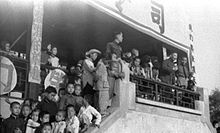
Between 1939 and 1945,Chiang Ching-kuo,son ofChiang Kai-shek,was appointed by theGovernment of the Republic of Chinaas commissioner of Ganzhou Prefecture (mountain South), then the name of the surrounding regions of Ganzhou. There he bannedopium smoking,gambling and prostitution, studied governmental management, allowed for economic expansion and a change in social outlook. His efforts were hailed as a miracle in the political war in China, then coined as the "Gannan New Deal" (Chinese:Cống nam tân chính). During his time in Gannan, from 1940 he implemented a "public information desk" where ordinary people could visit him if they had problems, and according to records, Chiang Ching-kuo received a total of 1,023 people during such sessions in 1942. In regards to the ban on prostitution and closing of brothels, Chiang implemented a policy where former prostitutes became employed in factories. Due to the large number of refugees in Ganzhou as a result from theongoing war,thousands of orphans lived on the street; in June 1942, Chiang Ching-kuo formally established the Chinese Children's Village (Chinese:Trung hoa nhi đồng tân thôn) in the outskirts of Ganzhou, with facilities such as a nursery, kindergarten, primary school, hospital and gymnasium.[4][5]
People's Republic of China
[edit]On August 14, 1949, thePeople's Liberation Armyestablished control of Gan County.[3]In June 1951, Ganzhou Prefecture (simplified Chinese:Cống châu chuyên khu;traditional Chinese:Cống châu chuyên khu) was established.[3]
In February 1999, Ganzhou was changed from a prefecture to aprefecture-level city.[3]
Administration
[edit]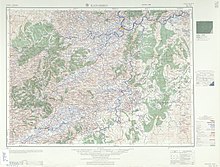
Ganzhou has jurisdiction over 3districts,2county-level cities,13counties:
- District
- Zhanggong District(Chương cống khu)
- Nankang District(Nam khang khu)
- Ganxian District(Cống huyện khu)
- County-level cities
- Counties
- Yudu County(Vu đô huyện)
- Xingguo County(Hưng quốc huyện)
- Ningdu County(Ninh đô huyện)
- Shicheng County(Thạch thành huyện)
- Huichang County(Hội xương huyện)
- Xunwu County(Tầm ô huyện)
- Anyuan County(An viễn huyện)
- Dingnan County(Định nam huyện)
- Quannan County(Toàn nam huyện)
- Xinfeng County(Tín phong huyện)
- Dayu County(Đại dư huyện)
- Chongyi County(Sùng nghĩa huyện)
- Shangyou County(Thượng do huyện)
| Map |
|---|
Geography
[edit]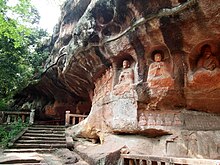
Ganzhou is a large city covering the southern third of Jiangxi, with an area of 39,400 square kilometres (15,200 sq mi). More than 70% of its administrative area is forested, and over 83% is also mountainous. Several of the major tributaries of the Gan River, Ganzhou's namesake, join at a confluence in the center of the city. Bordering prefecture-level cities are:
- Chenzhou– west
Jiangxi:
Climate
[edit]Ganzhou has ahumid subtropical climate(KöppenCfa) affected by theEast Asianmonsoon,with long, humid, very hot summers and cool and drier winters with occasional cold snaps. The monthly 24-hour average temperature ranges from 8.2 °C (46.8 °F) in January to 29.5 °C (85.1 °F) in July, with an annual average of 19.57 °C (67.2 °F). The average annual precipitation is around 1,450 mm (57 in). With monthly percent possible sunshine ranging from 20% in March to 62% in July, the city receives 1,778 hours of bright sunshine annually. Winter begins somewhat sunny and dry but becomes progressively wetter and cloudier; spring begins especially gloomy, and from March to June each of the months averages more than 170 mm (6.7 in) of rainfall. After the heavy rains subside in June, summer is especially sunny. Autumn is warm and relatively dry.
| Climate data for Ganzhou (Ganxian District) (1991–2020 normals, extremes 1981–2010) | |||||||||||||
|---|---|---|---|---|---|---|---|---|---|---|---|---|---|
| Month | Jan | Feb | Mar | Apr | May | Jun | Jul | Aug | Sep | Oct | Nov | Dec | Year |
| Record high °C (°F) | 27.7 (81.9) |
29.5 (85.1) |
32.2 (90.0) |
35.1 (95.2) |
36.5 (97.7) |
38.4 (101.1) |
40.0 (104.0) |
41.2 (106.2) |
38.8 (101.8) |
36.6 (97.9) |
32.8 (91.0) |
29.1 (84.4) |
41.2 (106.2) |
| Mean daily maximum °C (°F) | 12.6 (54.7) |
15.5 (59.9) |
18.7 (65.7) |
25.0 (77.0) |
29.1 (84.4) |
31.8 (89.2) |
34.7 (94.5) |
34.1 (93.4) |
30.9 (87.6) |
26.6 (79.9) |
21.1 (70.0) |
15.1 (59.2) |
24.6 (76.3) |
| Daily mean °C (°F) | 8.4 (47.1) |
11.0 (51.8) |
14.4 (57.9) |
20.3 (68.5) |
24.5 (76.1) |
27.4 (81.3) |
29.7 (85.5) |
29.0 (84.2) |
26.2 (79.2) |
21.5 (70.7) |
16.0 (60.8) |
10.3 (50.5) |
19.9 (67.8) |
| Mean daily minimum °C (°F) | 5.7 (42.3) |
8.0 (46.4) |
11.4 (52.5) |
16.9 (62.4) |
21.1 (70.0) |
24.3 (75.7) |
26.0 (78.8) |
25.5 (77.9) |
22.8 (73.0) |
17.9 (64.2) |
12.5 (54.5) |
7.0 (44.6) |
16.6 (61.9) |
| Record low °C (°F) | −6.0 (21.2) |
−4.4 (24.1) |
−0.3 (31.5) |
4.2 (39.6) |
11.1 (52.0) |
15.6 (60.1) |
19.1 (66.4) |
19.7 (67.5) |
13.1 (55.6) |
5.2 (41.4) |
−0.4 (31.3) |
−3.8 (25.2) |
−6.0 (21.2) |
| Averageprecipitationmm (inches) | 71.6 (2.82) |
96.2 (3.79) |
173.5 (6.83) |
161.6 (6.36) |
224.5 (8.84) |
205.4 (8.09) |
135.2 (5.32) |
154.3 (6.07) |
75.8 (2.98) |
48.7 (1.92) |
65.6 (2.58) |
50.9 (2.00) |
1,463.3 (57.6) |
| Average precipitation days(≥ 0.1 mm) | 11.7 | 13.0 | 18.2 | 16.2 | 16.9 | 16.0 | 11.4 | 13.6 | 9.3 | 6.0 | 7.9 | 9.0 | 149.2 |
| Average snowy days | 1.3 | 1.0 | 0.1 | 0 | 0 | 0 | 0 | 0 | 0 | 0 | 0 | 0.4 | 2.8 |
| Averagerelative humidity(%) | 76 | 76 | 79 | 76 | 76 | 76 | 69 | 72 | 73 | 70 | 73 | 73 | 74 |
| Mean monthlysunshine hours | 82.7 | 84.0 | 79.9 | 114.4 | 139.9 | 162.6 | 253.3 | 223.0 | 175.3 | 168.0 | 139.0 | 124.4 | 1,746.5 |
| Percentpossible sunshine | 25 | 26 | 21 | 30 | 34 | 40 | 61 | 56 | 48 | 47 | 43 | 38 | 39 |
| Source:China Meteorological Administration[6][7][8] | |||||||||||||
Demographics
[edit]Its population was 8,970,014 at the2020 Chinese censuswhom 2,588,060 in the built-up (or metro) area made of Zhanggong, Nankang, and Ganxian Districts.
As of 2019, Ganzhou'sbirth rateis 12.96 per 1,000.[9]
Economy
[edit]As of 2021, Ganzhou'sgross domestic product(GDP) totaled ¥416.9 billion, an 9.5% increase from the previous year.[10]Of this, ¥37.632 billion (10.83%) came from the city'sprimary sector,¥136.819 billion (39.38%) came from the city'ssecondary sector,and ¥172.983 billion came (49.79%) from the city'stertiary sector.[10]The city's GDP per capita totaled ¥35,341.74.[10]
As of 2019, theper capitadisposable incomeof the Ganzhou's urban residents totaled ¥34,826, and the per capita disposable income of the Ganzhou's rural residents totaled ¥11,941.[11]
In 2011, Ganzhou's gross domestic product totaled ¥133.598 billion.[12]
Tourism
[edit]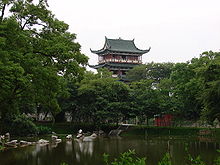
Ganzhou is known as the "Orange Capital of the World"[13][14]as well as the "Tungsten Capital of the World".[15]The world's largest mechanical clock is located in Ganzhou called the Harmony Clock Tower,[16]which was manufactured by UK-based clockmakersSmith of Derby Group.Though encircled by mountain scenery, other notable attractions in Jiangxi areJingdezhen,NanchangandLushanamong others. Some of the places of interest in Ganzhou include:
- Mount Jiulian(Cửu liên sơn), Longnan County
- Mei Pass,Dayu County
- Cuiwei Peak(Thúy vi phong), Ningdu County
- Hakka architecture:Some of the most representative Hakka houses include Guanxi Xinwei (Quan tây tân vi) ofLongnan;Yanji Wei (Yến dực vi), of Yangcun (Dương thôn); Longguang Wei (Long quang vi) of Taojiang (Đào giang); and Dongsheng Wei (Đông sinh vi) ofAnyuan,etc.
- Yugu Pavilion,Zhanggong District
- Bajing Pavilion,Zhanggong District
- Dongjin Bridge:Pontoon bridgeshave been constructed over the Zhang and Gong rivers since the Song dynasty. The Dongjin Bridge is one that can still be seen. It is 400 metres long, made up of wooden planks placed on around 100 wooden boats linked together with iron chains.
- Zao'er Alley(Táo nhi hạng), Zhanggong District: An alley dating to at least theSong dynasty,with a length of 227.3 m (746 ft).[17]
Zhanggong has acity walldating to the Song dynasty, as well as a number of pavilions andBuddhistandTaoisttemples from theMingandQing.Altogether there are some 17National Cultural Relic Protection Unitsin Ganzhou and 48 Provincial-level Cultural Relic Protection Units.
Media
[edit]Ganzhou Daily covers news about Ganzhou.
Transportation
[edit]Roads and highways
[edit]- China National Highways:G 105,G 206,G 319,G 323.
- Expressways of China:G45 Daqing–Guangzhou ExpresswayandG76 Xiamen–Chengdu Expressway.
Railway
[edit]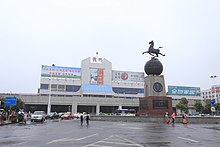
TheBeijing-Jiulong Railwaygoes through Ganzhou from north to south, and it meets theGanzhou–Longyan Railway(Ganlong line) at East Ganzhou Railway Station in Zhanggong District.Nanchang–Shenzhen high-speed railwayis under construction. TheGanzhou–Shenzhen high-speed railwayopened on 10 December 2021 and connects Ganzhou withShenzhen.
Major railway stations in Ganzhou are:
- Ganzhou, Xingguo, Nankang, Xinfeng, Longnan and Dingnan (Beijing-Jiulong Railway)
- Ganxian, Yudu, Huichang, Ruijin (Ganzhou-Longyan Railway)
Air
[edit]
The newGanzhou Huangjin Airport,located inNankang,was opened on March 26, 2008. Its name inherited from theold Huangjin Airportin Huangjin Town,Zhanggong District,which was closed since it was too close to the expanding Ganzhou urban area. It has domestic routes toShenzhen,Guangzhou,Nanchang,Xiamen,Nanjing,Shanghai,Nanning,ChongqingandBeijing.
Notable people
[edit]- Nobel LaureateGao Xingjian(Nobel Prize for literature in 2000) was born in Ganzhou.
- ArtistHu Zhiyingwas born November 12, 1959, in Ganzhou.
- ActressZhu Xijuanwas born in Ganzhou.
- ProfessorLi Pengwas born in Ganzhou.
Sister cities
[edit] McAllen, Texas,United States, since 1994.
McAllen, Texas,United States, since 1994. Roissy-en-France,Val-d'Oise,France, since 2008.[18]
Roissy-en-France,Val-d'Oise,France, since 2008.[18] Freetown,Sierra Leone, since 2008.
Freetown,Sierra Leone, since 2008. Brunswick, Georgia,United States, since 2008.
Brunswick, Georgia,United States, since 2008. Phocis,Greece, since 2011.[19]
Phocis,Greece, since 2011.[19] Limeira, São Paulo,Brazil, since 2013.
Limeira, São Paulo,Brazil, since 2013.
Notes
[edit]- ^"China: Jiāngxī (Prefectures, Cities, Districts and Counties) - Population Statistics, Charts and Map".www.citypopulation.de.
- ^Quốc dân kinh tế hòa xã hội phát triển ( tổng hợp )(in Simplified Chinese). Ganzhou Municipal People's Government. Archived fromthe originalon 2021-03-07.Retrieved2021-03-07.
- ^abcdefghijklmnopqrKiến trí duyên cách[Organizational History] (in Chinese). Ganzhou Municipal People's Government. 2020-11-16.Archivedfrom the original on 2021-03-07.Retrieved2021-03-07.
- ^"Diocese of Ganzhou".www.ucanews.com.Retrieved2023-05-13.
- ^"Chiang Ching-kuo and the Regional Planning of Gannan under the Influence of Soviet Experience (1941-1945)"(PDF).Retrieved2023-05-13.
- ^Trung quốc khí tượng sổ cư võng – WeatherBk Data(in Simplified Chinese).China Meteorological Administration.Retrieved30 July2023.
- ^ Trung quốc khí tượng sổ cư võng(in Simplified Chinese).China Meteorological Administration.Retrieved30 July2023.
- ^Trung quốc địa diện quốc tế giao hoán trạm khí hầu tiêu chuẩn trị nguyệt trị sổ cư tập ( 1971-2000 niên )(in Chinese).China Meteorological Administration.Archived fromthe originalon 2013-09-21.Retrieved2010-05-04.
- ^Nhân khẩu dữ dân tộc[Population and Ethnicity] (in Chinese). Ganzhou Municipal People's Government. 2020-11-16.Archivedfrom the original on 2021-03-07.Retrieved2021-03-07.
- ^abcQuốc dân kinh tế hòa xã hội phát triển ( tổng hợp )[National Economic and Social Development (Comprehensive)] (in Chinese). Ganzhou Municipal People's Government. 2020-09-16.Archivedfrom the original on 2021-03-07.Retrieved2021-03-07.
- ^Quốc dân kinh tế hòa xã hội phát triển ( nhân dân sinh hoạt dữ xã hội bảo chướng )[National Economic and Social Development (People's Livelihoods and Social Security)] (in Chinese). Ganzhou Municipal People's Government. 2020-09-16.Archivedfrom the original on 2021-03-07.Retrieved2021-03-07.
- ^Cống châu thị 2011 niên toàn niên chủ yếu kinh tế chỉ tiêu[Ganzhou 2011 Primary Economic Index] (in Chinese). Ganzhou Municipal People's Government. 2012-02-02. Archived fromthe originalon 2016-03-04.Retrieved2021-03-07.
- ^"Thế giới chanh hương" cống châu sang tạo tề chanh tiêu thụ kỳ tích 112 vạn đốn thụ không(in Chinese (China)). Jiangxi Times. 2010-05-25. Archived fromthe originalon 2011-07-26.Retrieved2011-01-23.
- ^"Contest Entry Notice for the Design of the Logo of" Ganzhou-World Capital of the Navel Orange "".Ganzhou Daily. 2010-01-13. Archived fromthe originalon 2010-09-26.Retrieved2011-01-23.
- ^"Ganzhou the world's largest tungsten supplier".China Daily. 2007-12-21.Retrieved2011-01-13.
- ^"Ganzhou World's Largest Mechanical Clock".Ganzhou Daily. 2010-07-14. Archived fromthe originalon 2011-07-26.Retrieved2011-01-23.
- ^Jiang, Peiheng ( giang bội hoành ).Tạo nhi hạng chi hành ( tổ đồ )- sưu hồ tân văn.Thiên tân nhật báo– viaSohuNews.
- ^http://www.aaecf.com/shownew.asp?id=543Archived2012-02-16 at theWayback Machine"Ganzhou and Roissy become sister cities", Association Amitié Euro-Chinoise (Chinese)
- ^Μνημόνιο Φιλίας και Συνεργασίας μεταξύ της περιφερειακής ενότητας Φωκίδας και της περιοχής Ganzhou της Κίνας.aftodioikisi.gr(in Greek). Archived fromthe originalon 2012-01-08.
External links
[edit]- Ganzhou, Jiangxi (Chinese)Archived2010-11-15 at theWayback Machine
 Ganzhoutravel guide from Wikivoyage
Ganzhoutravel guide from Wikivoyage


